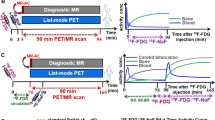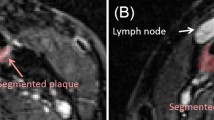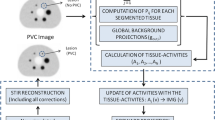Abstract
Errors in quantification of carotid positron emission tomography (PET) in simultaneous PET/magnetic resonance (PET/MR) imaging when not incorporating bone in MR-based attenuation correction (MRAC) maps, and possible solutions, remain to be fully explored. In this study, we demonstrated techniques to improve carotid vascular PET/MR quantification by adding a bone tissue compartment to MRAC maps and deriving continuous Dixon-based MRAC (MRACCD) maps. We demonstrated the feasibility of applying ultrashort echo time-based bone segmentation and generation of continuous Dixon MRAC to improve PET quantification on five subjects. We examined four different MRAC maps: system standard PET/MR MRAC map (air, lung, fat, soft tissue) (MRACPET/MR), standard PET/MR MRAC map with bone (air, lung, fat, soft tissue, bone) (MRACPET/MRUTE), MRACCD map (no bone) and continuous Dixon-based MRAC map with bone (MRACCDUTE). The same PET emission data was then reconstructed with each respective MRAC map and a CTAC map (PETPET/MR, PETPET/MRUTE, PETCD, PECDUTE) to assess effects of the different attenuation maps on PET quantification in the carotid arteries and neighboring tissues. Quantitative comparison of MRAC attenuation values for each method compared to CTAC showed small differences in the carotid arteries with UTE-based segmentation of bone included and/or continuous Dixon MRAC; however, there was very good correlation for all methods in the voxel-by-voxel comparison. ROI-based analysis showed a similar trend in the carotid arteries with the lowest correlation to PETCTAC being PETPETMR and the highest correlation to PETCTAC being PETCDUTE. We have demonstrated the feasibility of applying UTE-based segmentation and continuous Dixon MRAC maps to improve carotid PET/MR vascular quantification.






Similar content being viewed by others
References
Fayad ZA, Mani V, Woodward M, Kallend D, Abt M, Burgess T, Fuster V, Ballantyne CM, Stein EA, Tardif J-C, Rudd JHF, Farkouh ME, Tawakol A (2011) Safety and efficacy of dalcetrapib on atherosclerotic disease using novel non-invasive multimodality imaging (dal-PLAQUE): a randomised clinical trial. Lancet 378(9802):1547–1559
Mani V, Woodward M, Samber D, Bucerius J, Tawakol A, Kallend D, Rudd JHF, Abt M, Fayad ZA (2014) Predictors of change in carotid atherosclerotic plaque inflammation and burden as measured by 18-FDG-PET and MRI, respectively, in the dal-PLAQUE study. Int J Cardiovasc Imaging 30(3):571–582
Heusch P, Buchbender C, Beiderwellen K, Nensa F, Hartung-Knemeyer V, Lauenstein TC, Bockisch A, Forsting M, Antoch G, Heusner TA (2013) Standardized uptake values for [(18)F] FDG in normal organ tissues: comparison of whole-body PET/CT and PET/MRI. Eur J Radiol 82(5):870–876
Drzezga A, Souvatzoglou M, Eiber M, Beer AJ, Fürst S, Martinez-Möller A, Nekolla SG, Ziegler S, Ganter C, Rummeny EJ, Schwaiger M (2012) First clinical experience with integrated whole-body PET/MR: comparison to PET/CT in patients with oncologic diagnoses. J Nucl Med 53(6):845–855
Samarin A, Burger C, Wollenweber SD, Crook DW, Burger IA, Schmid DT, Schulthess GK, Kuhn FP (2012) PET/MR imaging of bone lesions—implications for PET quantification from imperfect attenuation correction. Eur J Nucl Med Mol Imaging 39(7):1154–1160
Akbarzadeh A, Ay MR, Ahmadian A, Alam NR, Zaidi H (2013) MRI-guided attenuation correction in whole-body PET/MR: assessment of the effect of bone attenuation. Ann Nucl Med 27(2):152–162
Aznar MC, Sersar R, Saabye J, Ladefoged CN, Andersen FL, Rasmussen JH, Löfgren J, Beyer T (2014) Whole-body PET/MRI: the effect of bone attenuation during MR-based attenuation correction in oncology imaging. Eur J Radiol 83(7):1177–1183
Keereman V, Van Holen R, Mollet P, Vandenberghe S (2011) The effect of errors in segmented attenuation maps on PET quantification. Med Phys 38(11):6010–6019
Andersen FL, Ladefoged CN, Beyer T, Keller SH, Hansen AE, Højgaard L, Kjær A, Law I, Holm S (2014) Combined PET/MR imaging in neurology: MR-based attenuation correction implies a strong spatial bias when ignoring bone. Neuroimage 84:206–216
Wiesmüller M, Quick HH, Navalpakkam B, Lell MM, Uder M, Ritt P, Schmidt D, Beck M, Kuwert T, von Gall CC (2013) Comparison of lesion detection and quantitation of tracer uptake between PET from a simultaneously acquiring whole-body PET/MR hybrid scanner and PET from PET/CT. Eur J Nucl Med Mol Imaging 40(1):12–21
Ripa RS, Knudsen A, Hag AMF, Lebech A-M, Loft A, Keller SH, Hansen AE, von Benzon E, Højgaard L, Kjær A (2013) Feasibility of simultaneous PET/MR of the carotid artery: first clinical experience and comparison to PET/CT. Am J Nucl Med Mol Imaging 3(4):361–371
Martinez-Möller A, Souvatzoglou M, Delso G, Bundschuh RA, Chefdhotel C, Ziegler SI, Navab N, Schwaiger M, Nekolla SG (2009) Tissue classification as a potential approach for attenuation correction in whole-body PET/MRI: evaluation with PET/CT data. J Nucl Med 50(4):520–5266
Keereman V, Fierens Y, Broux T, De Deene Y, Lonneux M, Vandenberghe S (2010) MRI-based attenuation correction for PET/MRI using ultrashort echo time sequences. J Nucl Med 51(5):812–818
Catana C, van der Kouwe A, Benner T, Michel CJ, Hamm M, Fenchel M, Fischl B, Rosen B, Schmand M, Sorensen AG (2010) Toward implementing an MRI-based PET attenuation–correction method for neurologic studies on the MR-PET brain prototype. J Nucl Med 51(9):1431–1438
Berker Y, Franke J, Salomon A, Palmowski M, Donker HCW, Temur Y, Mottaghy FM, Kuhl C, Izquierdo-Garcia D, Fayad ZA, Kiessling F, Schulz V (2012) MRI-based attenuation correction for hybrid PET/MRI systems: a 4-class tissue segmentation technique using a combined ultrashort-echo-time/Dixon MRI sequence. J Nucl Med 53(5):796–804
Navalpakkam BK, Braun H, Kuwert T, Quick HH (2013) Magnetic resonance-based attenuation correction for PET/MR hybrid imaging using continuous valued attenuation maps. Invest Radiol 48(5):323–332
Delso G, Zeimpekis K, Carl M, Wiesinger F, Hüllner M, Veit-haibach P (2014) Cluster-based segmentation of dual-echo ultra-short echo time images for PET/MR bone localization, pp 1–13
Johansson A, Karlsson M, Nyholm T (2011) CT substitute derived from MRI sequences with ultrashort echo time. Med Phys 38(5):2708
Marshall HR, Patrick J, Laidley D, Prato FS, Butler J, Théberge J, Thompson RT, Stodilka RZ (2013) Description and assessment of a registration-based approach to include bones for attenuation correction of whole-body PET/MRI. Med Phys 40(8):082509
Delso G, Fürst S, Jakoby B, Ladebeck R, Ganter C, Nekolla SG, Schwaiger M, Ziegler SI (2011) Performance measurements of the Siemens mMR integrated whole-body PET/MR scanner. J Nucl Med 52(12):1914–1922
Burger C, Goerres G, Schoenes S, Buck A, Lonn AHR, Von Schulthess GK (2002) PET attenuation coefficients from CT images: experimental evaluation of the transformation of CT into PET 511-keV attenuation coefficients. Eur J Nucl Med Mol Imaging 29(7):922–927
Bini J, Izquierdo-Garcia D, Mateo J, Machac J, Narula J, Fuster V, Fayad ZA (2013) Preclinical evaluation of MR attenuation correction versus CT attenuation correction on a sequential whole-body MR/PET scanner. Invest Radiol 48(5):313–322
Bini J, Robson PM, Calcagno C, Eldib M, Fayad ZA (2015) Quantitative carotid PET/MR imaging: clinical evaluation of MR-attenuation correction versus CT-attenuation correction in 18F-FDG PET/MR emission data and comparison to PET/CT. Am J Nucl Med Mol Imaging (in press)
Quick HH (2014) Integrated PET/MR. J Magn Reson Imaging 39(2):243–258
Eldib M, Bini J, Robson PM, Faul D, Fayad ZA (2014) Attenuation correction for flexible MRI coils using the ultra-short echo time sequence in MR/PET imaging. Proc Intl Soc Mag Reson Med 22:0784
Rudd JHF, Myers KS, Bansilal S, Machac J, Pinto CA, Tong C, Rafique A, Hargeaves R, Farkouh M, Fuster V, Fayad ZA (2008) Atherosclerosis inflammation imaging with 18F-FDG PET: carotid, iliac, and femoral uptake reproducibility, quantification methods, and recommendations. J Nucl Med 49(6):871–878
Bucerius J, Mani V, Moncrieff C, Machac J, Fuster V, Farkouh ME, Tawakol A, Rudd JHF, Fayad ZA (2014) Optimizing 18F-FDG PET/CT imaging of vessel wall inflammation: the impact of 18F-FDG circulation time, injected dose, uptake parameters, and fasting blood glucose levels. Eur J Nucl Med Mol Imaging 41(2):369–383
Bland JM, Altman DG (1986) Statistical methods for assessing agreement between two methods of clinical measurement. Lancet 1:307–310
Acknowledgments
The authors would like to thank Siemens Healthcare for technical support. This work was supported in part by NIH/NHLBI RO1 HL071021 and NIH/NCATS CTSA UL1TR000067) (Z.A.F.) and an American Heart Association Student Scholarship in Cardiovascular Disease (J.B.).
Conflict of interest
None.
Author information
Authors and Affiliations
Corresponding author
Rights and permissions
About this article
Cite this article
Bini, J., Eldib, M., Robson, P.M. et al. Simultaneous carotid PET/MR: feasibility and improvement of magnetic resonance-based attenuation correction. Int J Cardiovasc Imaging 32, 61–71 (2016). https://doi.org/10.1007/s10554-015-0661-7
Received:
Accepted:
Published:
Issue Date:
DOI: https://doi.org/10.1007/s10554-015-0661-7




